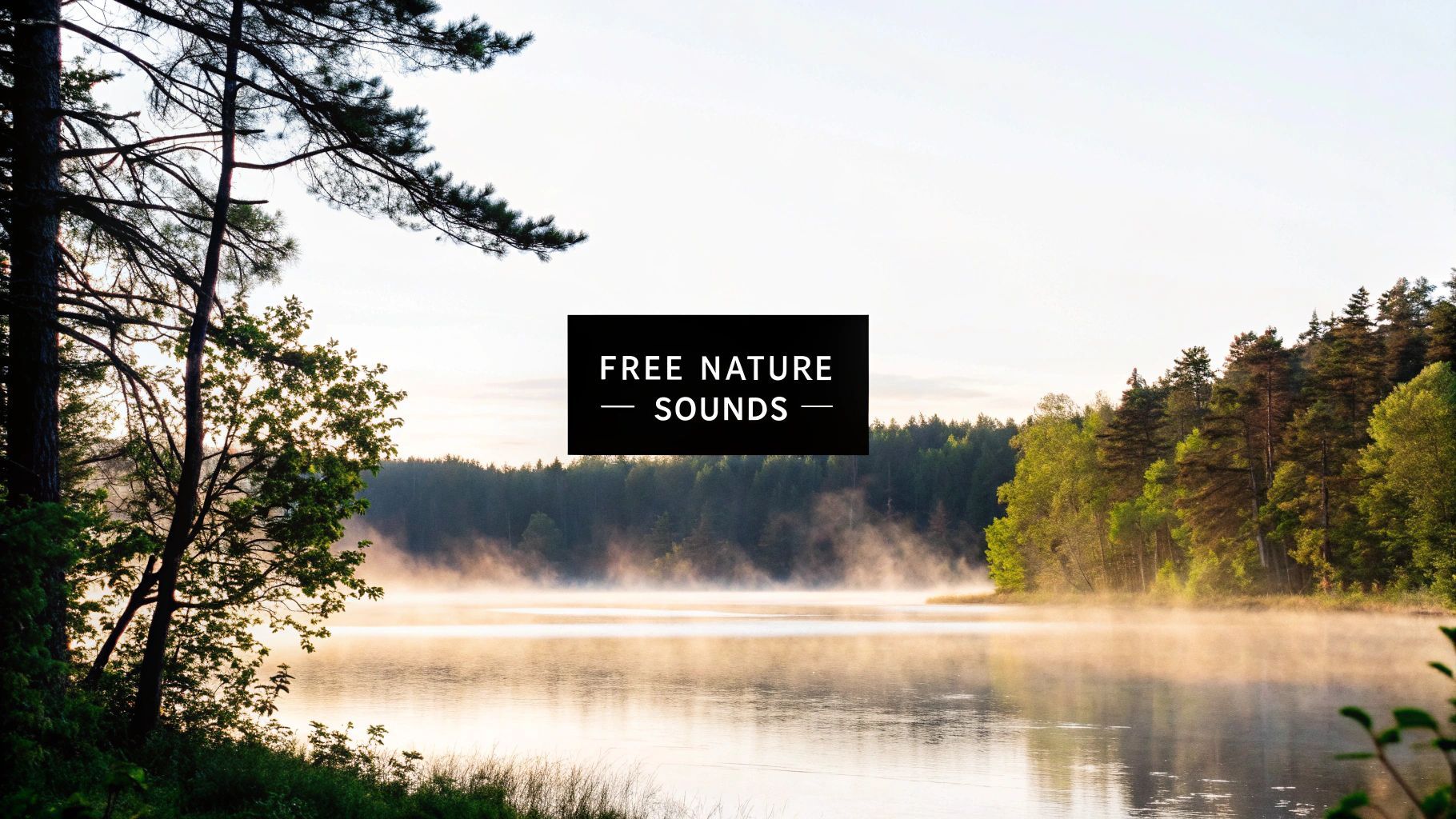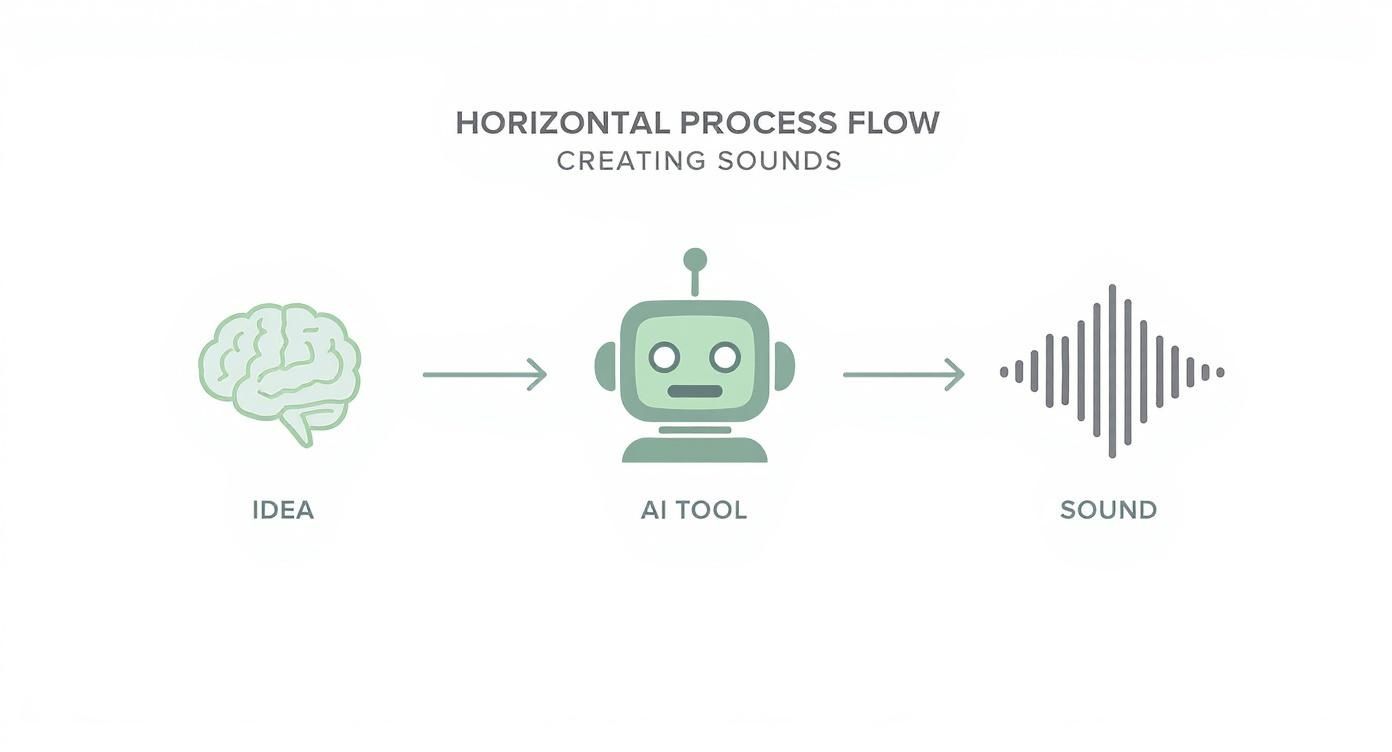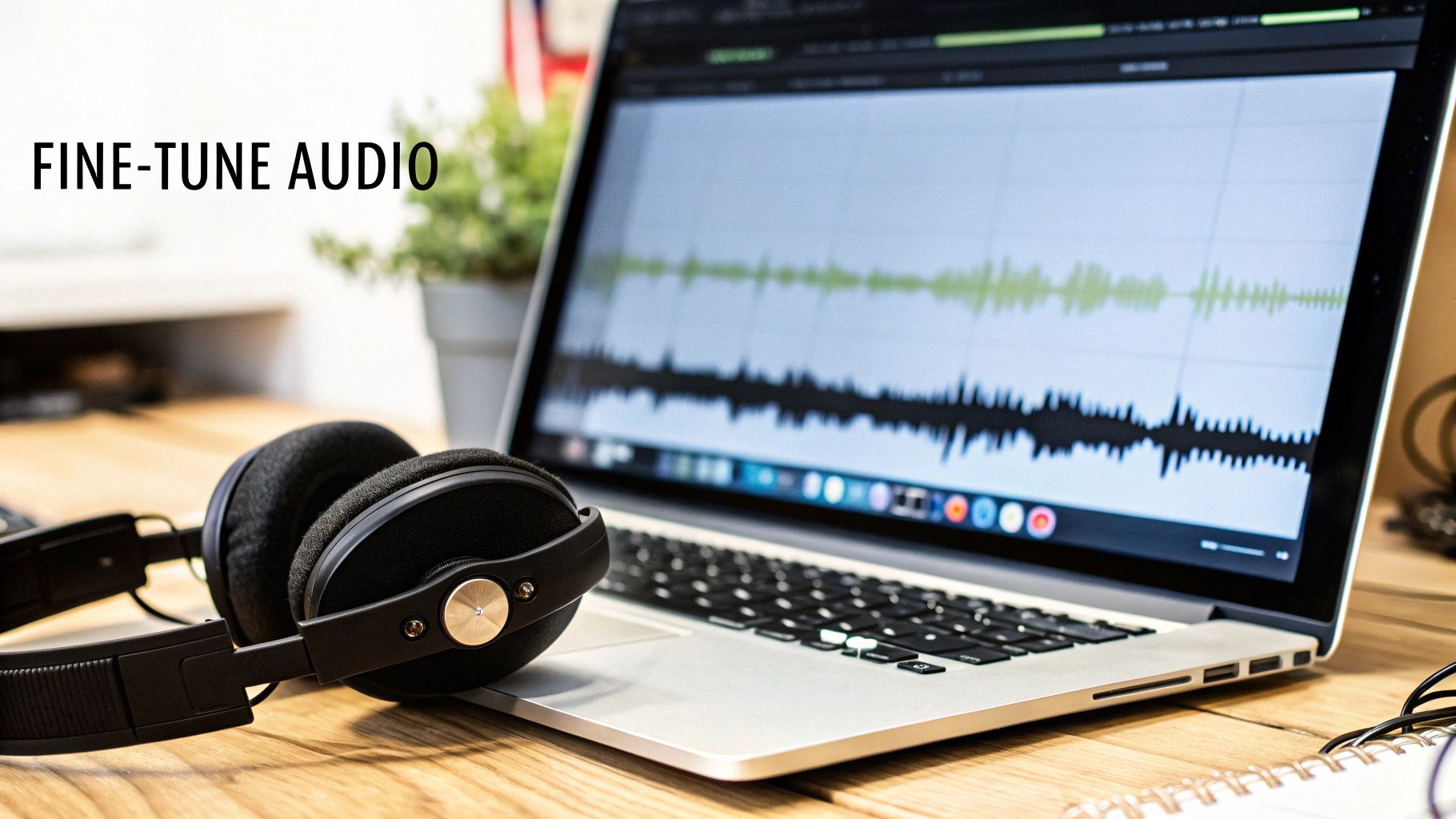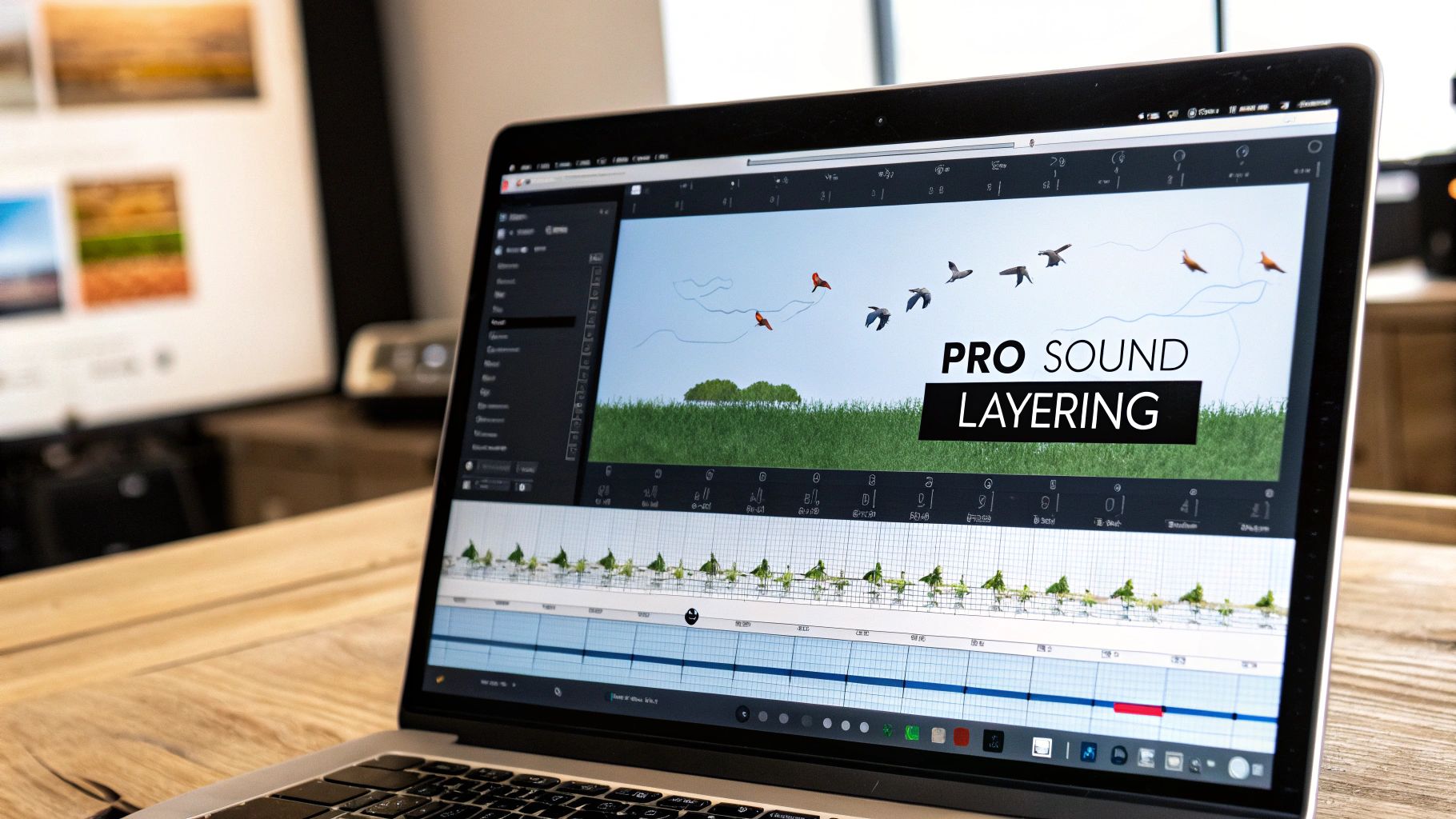
If you're on the hunt for high-quality, free nature sounds, your best bet is no longer scrolling through old-school audio libraries. The real power is now in AI tools like SFX Engine, which let you generate completely custom, royalty-free soundscapes from a simple text prompt. It's like having a sound studio right in your browser.
Picture this: you need the perfect sound of gentle rain for a meditation app, or maybe a crisp forest ambience for your podcast intro. In the past, this meant hours spent digging through stock libraries, hoping to find something that was almost right, all while trying to decipher complicated licensing agreements.
Thankfully, there’s a much better way. AI sound generation lets you create unique, high-quality, and totally free audio that fits your exact vision. It’s a massive leap forward for creators, wellness professionals, and anyone who needs the perfect natural soundscape. To get a feel for just how powerful these sounds can be, it's worth exploring the variety of 7 calming sounds for sleep that people find effective.
The biggest win with AI sound generation is the sheer level of control it gives you. Instead of settling for a pre-recorded track that’s just "close enough," you can craft the exact audio you hear in your head. This opens up a ton of creative possibilities for all kinds of projects.
Just think about the benefits:
The real advantage here is the specificity. You can go way beyond a generic 'forest sound' and create something like a 'pine forest after a light spring rain with a distant woodpecker tapping.' That kind of detail used to be reserved for professional sound engineers with expensive gear.
Now, let's quickly break down how this new approach stacks up against the old way of doing things.
| Feature | Traditional Libraries | AI Sound Generation |
|---|---|---|
| Customization | Low (limited to existing files) | High (endless text prompt variations) |
| Cost | Often subscription-based or per-track | Typically free or freemium models |
| Licensing | Can be complex and restrictive | Simple, usually royalty-free |
| Uniqueness | Low (same sounds used by many) | High (each generation is unique) |
| Speed | Slow (requires searching & browsing) | Fast (generate in minutes) |
As you can see, AI-powered tools offer a clear advantage in flexibility and freedom. You're no longer just a consumer of sounds—you're the creator.
Getting the perfect sound from your imagination into an audio file is an art form. Your text prompt is your paintbrush, and moving beyond simple phrases like "forest sound" is how you create something truly special. The real trick is to think like a sound designer, layering in the small details to guide the AI toward the soundscape you have in mind.
Instead of just "rain," try something with more character. A much better prompt would be "gentle rain falling on a tent roof with distant, soft thunder rolling." See the difference? That extra bit of context gives the AI so much more to work with, influencing the texture and complexity of the final audio. It's what turns a generic sound effect into a believable atmosphere.
To really dial in your results, I've found it helps to focus on three key areas in your prompts: intensity, distance, and environment. Each one adds another layer of realism.
This infographic breaks down how a simple idea becomes a real sound file using SFX Engine.

As you can see, your initial description is the most important step—it directly feeds the AI and shapes the final waveform. This need for high-quality, specific audio is exploding. In fact, the global market for environmental background music is projected to hit USD 2.35 billion by 2033, with nature sounds accounting for a massive 45% of total consumption.
Let's walk through a practical example. Say you're editing a video and need an ambient track for a scene in a remote, cozy cabin.
Prompt: Peaceful crackling fire in a stone fireplace, light wind whistling outside a wooden cabin window, distant owl hoot, high fidelity.
This prompt works so well because it combines multiple sound sources (fire, wind, owl), gives the AI crucial environmental context (stone fireplace, wooden cabin), and even specifies the desired audio quality (high fidelity).
Getting the hang of layering these elements is the key. Our guide on using a free AI audio generator has even more tips for mastering this technique. The more you practice with specific, descriptive language, the better you'll get at telling the AI exactly what you need.

The initial sound generation is really just your starting point. Think of it as a block of marble—the real art happens when you start chipping away and refining it. An AI-generated track provides the raw material, but the built-in tools are what let you polish it into something perfect for your project.
Right off the bat, you can usually adjust the duration. Need a quick sound clip to match a 10-second video scene? Trim it down. Building a meditation app? You can easily extend a short sound into a seamless, long-form loop that won't distract the listener.
Here’s where things get really interesting. One of the most powerful features you’ll find is the ability to “Unmix” your audio, which basically means you can pull apart the different elements within the soundscape.
Let's say you've generated a forest scene. It sounds great, but the wind is a bit too gusty and it's drowning out the subtle birdsong you were after. With the unmix feature, you're no longer stuck with the initial mix.
You can now:
This level of control is what gives you the precision of a professional sound designer. You can take a good track and make it truly exceptional, ensuring every piece of your free audio nature sounds serves its purpose.
This surgical approach to audio editing is what separates amateur projects from professional ones. Having the ability to deconstruct and rebuild your soundscape ensures the final result aligns perfectly with your creative vision.
The demand for high-quality, customizable audio isn't just a niche interest; it's a massive market. In fact, royalty-free audio is projected to become a USD 2.03 billion industry by 2030, and AI is a huge part of that growth. By giving creators the power to generate unique sounds, AI is changing the game. You can dig deeper into this trend by exploring the royalty-free music market further.
You can see this principle in action in our guide on creating the perfect dripping water sound, available at https://sfxengine.com/blog/dripping-water-sound. It shows how tiny tweaks can make a massive difference in the mood and realism of your final audio. The same logic applies whether you're crafting a roaring campfire or the sound of a gentle stream.
https://www.youtube.com/embed/UJZxtO9XNno
Alright, so you’ve generated a whole library of unique, custom-made sounds. This is where the real fun starts. These audio files are more than just assets; they’re your secret weapon for adding a layer of professionalism and depth to all kinds of creative work. The potential for high-quality free audio nature sounds goes way beyond simple background noise.
Take podcasters and YouTubers, for example. You can instantly make your content stand out by creating a specific atmosphere that fits your brand perfectly. Forget those tired, overused stock sounds everyone else is using. A history podcast could transport listeners with the sound of wind whistling through ancient ruins. A travel vlogger could capture the unique vibe of a bustling tropical market before transitioning to the calm of a secluded beach.
The wellness world is another place where custom sounds are making a huge impact. In fact, the nature sounds therapy niche is projected to take up 35.2% of the entire global sound therapy market, largely driven by apps for managing stress. If you're an app developer or a meditation guide, you can craft soundscapes perfectly tuned for relaxation, focus, or sleep. It's a massive trend—you can learn more about the booming sound therapy market to see just how big it's getting.
Let's get practical. Here are a few real-world examples with prompts you can try right now:
The big shift here is moving from a consumer's mindset—just finding a sound that kind of fits—to a creator's mindset, where you build the exact sound you need from scratch. Having that level of control over your audio is a total game-changer.
Imagine you're designing a level for a fantasy game set in an enchanted wood. Your prompt could be something like: "Magical forest with glowing mushrooms, faint chiming sounds, gentle stream flowing, distant ethereal animal calls." That creates a completely immersive world that no generic sound library could ever replicate.
Filmmakers can use this technique to generate hyper-specific foley effects without booking a pricey recording studio. Need the sound of a particular kind of storm? Don't settle for a generic thunderstorm. If you’re shooting a coastal scene and need that perfect sound of the sea, dive into our guide on generating realistic and royalty-free ocean sounds for more detailed tips. The creative doors this opens are basically endless.

If you're aiming for studio-quality results, it's time to start thinking like a sound designer. The secret isn't just about writing a better prompt; it's about moving beyond a single sound file. The most powerful technique in any pro's toolkit is sound layering.
Instead of trying to generate one perfect, complex track, focus on creating several simpler, high-quality sounds. You can then import these individual elements into any audio editor and mix them together. This approach gives you granular control over the final product, allowing you to fine-tune volume, panning, and effects for each sound to build a truly rich and dynamic soundscape.
Let's say you're trying to build a dense, atmospheric forest scene. A single prompt might get you close, but layering will get you all the way there. Try generating three separate sounds:
When you mix these yourself, you decide exactly when and where the owl hoots. You can make sure the crickets are a subtle texture in the background, not an overpowering noise that drowns out the wind. It’s this level of control that elevates a generic sound into a truly immersive audio experience.
Professional sound design is all about building a scene, piece by piece. Layering individual sounds is like giving yourself a multi-track recording studio—you have ultimate control over every sonic detail to build the perfect environment.
Your prompts can also be much more precise. One of my favorite tricks is using negative prompts to exclude sounds I don't want. Simply add a minus sign before the word. For example, a prompt like "peaceful forest ambiance -no birds -no cars" gives you a much cleaner, more specific result.
You can also guide the AI by including terms that describe the audio quality you're after. Adding descriptors like 'high-fidelity,' 'ASMR,' or 'close-up recording' will directly shape the texture and clarity of your generated free audio nature sounds.
For bigger projects, don't be afraid to bring in other tools to help organize your thoughts. Sometimes I'll even use AI-powered outline generators to map out all the sonic elements I need for a complex soundscape before I even start generating the first track. A little planning goes a long way.
Of course, jumping into AI sound generation for the first time usually comes with a few questions. Creators often wonder about the practical side of things—licensing, quality, and just how far you can push the creative boundaries. Let's tackle some of the most common ones.
The biggest question I hear is about usage rights. With a tool like SFX Engine, the sounds you create are 100% royalty-free. This is a huge deal. It means you can use them in your commercial projects—YouTube videos, indie games, podcasts, you name it—without worrying about future fees or complicated licensing agreements.
Of course, it's always smart to glance at the terms of service for any platform, but the general idea is to give you total creative freedom.
This is where things get really interesting. People are often skeptical about the audio fidelity, but modern AI sound generators deliver professional-grade files in standard formats like WAV or MP3. The quality is clean and immersive, easily on par with what you'd find in expensive, traditional sound libraries.
But what about creative control? How specific can you actually get with your prompts? The answer is very. The AI's potential is really only capped by your own imagination.
The real magic happens when you start experimenting. The more you play with detailed, descriptive prompts, the better you'll get at coaxing the perfect sound out of the AI. Think of yourself as the conductor and the AI as your orchestra; your words are the sheet music.
Ready to start crafting your own unique soundscapes? With SFX Engine, you can generate custom, royalty-free audio in just a few seconds. Start creating your free audio nature sounds today at https://sfxengine.com.